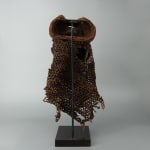Chokwe Mask, 20th Century CE
Wood
25 x 17 cm
9 7/8 x 6 3/4 in
9 7/8 x 6 3/4 in
ES.7698
Further images
This unusual mask was made in Angola, by the Chokwe group. It looks almost like a helmet mask in overall form, but it is a facemask with a large textile...
This unusual mask was made in Angola, by the Chokwe group. It looks almost like a helmet mask in overall form, but it is a facemask with a large textile and raffia hood that would effectively obscure the identity of the wearer. The form is unusual, with what appears to be a pedestal base, a narrow face and a domed forehead that has a central ridge running down to the nose. The eyes are small, but set within enormous sockets that are highlighted with kaolin pigment. The nose is long and triangular, while the mouth is very wide and grinning with numerous small, white-painted triangular teeth. The patina is dark and glossy. The hood is large and comprises various pieces of textile and other organic matter.
The Chokwe, or Tchokwe, are distributed across Angola, the DR of Congo and Zambia, and can trace their ancestry to the Lunda Empire of the 15th century, when a mass-migration occurred out of Lunda/Luba territory. The resulting kingdoms – including the Tchokwe, Luena, Songo, Ovimbundu and Imbagala – were all closely allied until the mid 19th century when the Tchokwe, following a great famine, migrated south. Their art and culture is thus distinctive compared to that of the other Lunda-descended tribes.
Society is governed by a God-King (Mwana Ngana), under whom men’s (Mugonge) and women’s (Ukule) societies control age classes and ensure social harmony. This system has resulted in a series of masks that are designed to defuse social tensions, celebrate important events (i.e. circumcisions), impose judiciary powers and promote fertility, health and well-being. The main mask forms for which the Tchokwe are known are the male Cihongo mask – which symbolises wealth, power and judicial authority – and the female Pwo mask, which is an embodiment of idealised femininity. The current piece is an exceptional example of the former. The two “sexes” were sometimes danced together at ceremonies to ensure fertility and prosperity.
In practical terms, the Cihongo mask as worn by a vassal of the king, and wearing it conferred judicial power upon him, for the collection of taxes, rates and the like. The identity of the wearer was concealed under the raffia train. This is an attractive piece of African art.
The Chokwe, or Tchokwe, are distributed across Angola, the DR of Congo and Zambia, and can trace their ancestry to the Lunda Empire of the 15th century, when a mass-migration occurred out of Lunda/Luba territory. The resulting kingdoms – including the Tchokwe, Luena, Songo, Ovimbundu and Imbagala – were all closely allied until the mid 19th century when the Tchokwe, following a great famine, migrated south. Their art and culture is thus distinctive compared to that of the other Lunda-descended tribes.
Society is governed by a God-King (Mwana Ngana), under whom men’s (Mugonge) and women’s (Ukule) societies control age classes and ensure social harmony. This system has resulted in a series of masks that are designed to defuse social tensions, celebrate important events (i.e. circumcisions), impose judiciary powers and promote fertility, health and well-being. The main mask forms for which the Tchokwe are known are the male Cihongo mask – which symbolises wealth, power and judicial authority – and the female Pwo mask, which is an embodiment of idealised femininity. The current piece is an exceptional example of the former. The two “sexes” were sometimes danced together at ceremonies to ensure fertility and prosperity.
In practical terms, the Cihongo mask as worn by a vassal of the king, and wearing it conferred judicial power upon him, for the collection of taxes, rates and the like. The identity of the wearer was concealed under the raffia train. This is an attractive piece of African art.









